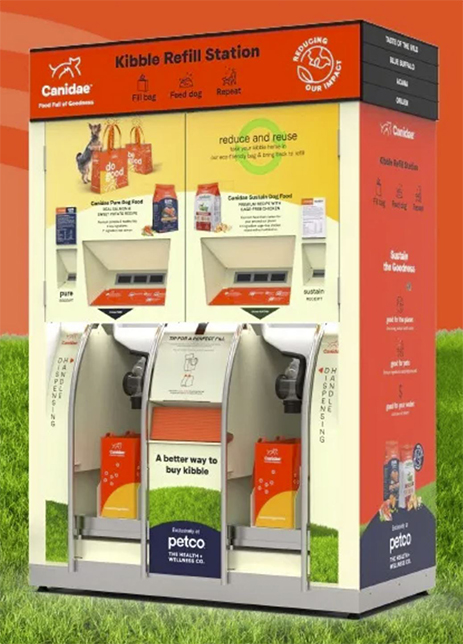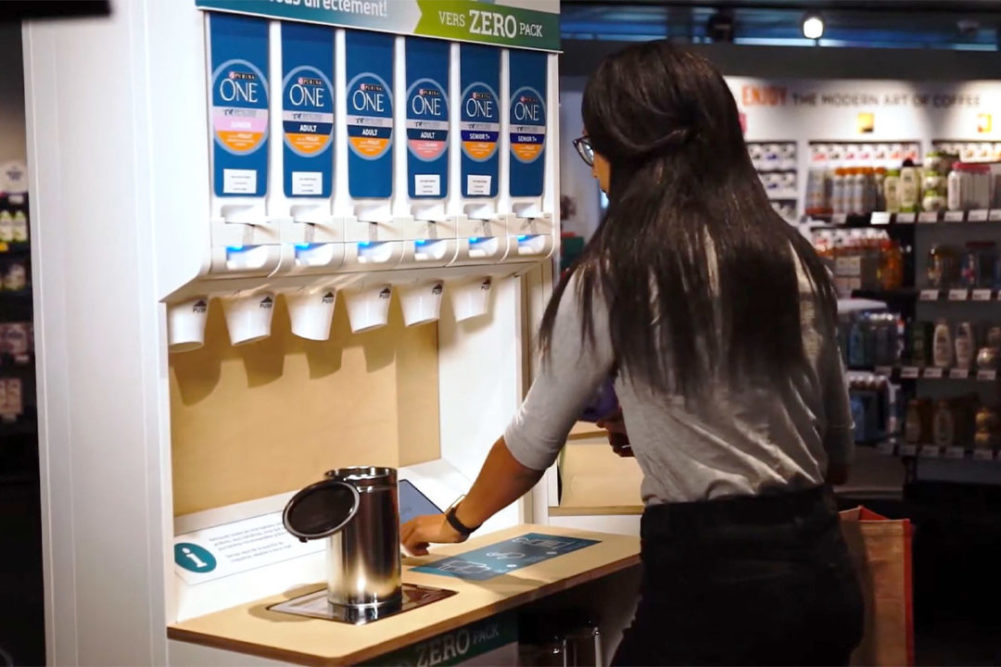BOULDER, COLO. — Packaging sustainability is a hot topic in today’s pet industry. During Global Pet Expo, NielsenIQ revealed the presence of sustainable packaging attributes for pet food products have grown by 92.3% over the last two years.
The conversation around sustainable packaging has shifted in recent years, expanding from traditional end-of-life circularity through recycling to include refillable and reusable solutions. This trend has been seen increasingly in the consumer goods space through subscription-based models for household products, and now some pet food companies are jumping in with refillable point-of-sale dispensers.
 Alison Younts, lead sustainability consultant at Trayak. (Source: LinkedIn)
Alison Younts, lead sustainability consultant at Trayak. (Source: LinkedIn)
Trayak, a consulting partner, sustainability software company and close partner of the Pet Sustainability Coalition (PSC), is leveraging life cycle assessment (LCA) as a tool to evaluate emerging circular packaging options. During PSC’s UnPacked22 virtual sustainable packaging conference, Alison Younts, lead sustainability consultant at Trayak, discussed how pet industry companies can use LCA to determine the environmental impacts and benefits of refillable packaging solutions.
Life cycle assessment (LCA)
LCA studies can be used to compare certain environmental baselines across different packaging materials. These studies can measure environmental impact at several levels, including material sourcing and processing, manufacturing, distribution, and end-of-life.
PSC partnered with Earth Animal in 2019 to conduct an LCA of bio-based packaging films compared to traditional materials. The study found bio-based packaging to use significantly fewer fossil fuels and emit less greenhouse gas, but require more water than both recycle-ready mono materials and petroleum-based plastic packaging.
For companies looking to explore new packaging options, which can be time-consuming and costly for brands, an LCA is a valuable tool for highlighting key tradeoffs from material to material in terms of environmental impact and feasibility.
“The life cycle assessment usually follows a linear pattern where you go from material, manufacturing, transportation, and then end of life is where it stops,” Younts explained. “But if we look at a refillable or reusable scenario, this allows us to have a paradigm shift, and a [more] circular approach, and we [can] incorporate recycling or reuse instead of end of life.”
Younts defined refillable and resusable packaging as “an umbrella of different sustainability strategies that companies take to reduce their single-use products.” This can be achieved in more than one way. For example, companies can provide a durable container or vessel for a product and ship refills directly to the consumer. Brands could also provide durable, reusable containers for products, collect them once the product inside has been used up, refill and return to the consumer to be used again.
 Canidae rolled out Kibble Refill stations at select Petco locations in the United States in an effort to reduce its single-use packaging. (Source: Canidae)
Canidae rolled out Kibble Refill stations at select Petco locations in the United States in an effort to reduce its single-use packaging. (Source: Canidae)
Premium pet food company Canidae is currently rolling out its own Kibble Refill Stations at select Petco locations, following a successful pilot of the stations with Petco in Southern California. The refillable pet food solution is expected to reduce the company’s single-use plastics and save consumers up to 45% per lb on dog food purchases. Currently, only two dry dog food formulas are available through the Kibble Refill Stations: Pure Real Salmon & Sweet Potato and Sustain Premium Recipe with Cage-Free Chicken.
In 2020, Nestlé piloted reusable, refillable pet food and coffee dispensers at select stores in Switzerland. Consumers were invited to bring their own packages to retail and get their fill of select Purina pet food and Nescafé coffee products. The pilot was successful, and the company announced plans to roll out additional dispensers in the months following.
Nestlé has also partnered with Loop, a circular packaging platform offering subscription-based, home-delivered products in reusable packages in the United States and France.
Breaking even
One thing Younts pointed out was the importance of tying upstream innovation in with downstream progress. This perspective is useful not only for the refillable category of sustainable packaging, but also for recyclable options. Brands must consider downstream conditions for collection infrastructure, retail drop-off and how to leverage emerging recycling technology in order to guide their upstream packaging innovations.
In some sense, initial optimism for refillable packaging has been tampered by a deeper understanding of what it takes to make this type of packaging feasible.
“It can involve more intensive materials or processes, reverse logistics, washing or sanitization cycles — especially with a reusable package — and redesigning or reconfiguring the entire supply chain,” Younts said. “These were just a few of the challenges that came to mind when we thought about reuse and a more realistic framework.”
To this end, Trayak worked to develop a more comprehensive LCA for reusable and refillable options. The company identified a few key parameters affecting the sustainability of these solutions, including the use or refill rate of the product to determine durability, as well as the return rate and reverse logistics challenges like expected breakage or loss, transportation, and sanitation.
“For example, if a reusable or refillable component has to be much heavier to withstand the reuse, then the expected use rate needs to be enough to counteract more materials [used] in the process that goes into that heavier package,” Younts said.
For refillable solutions, she noted average return rates will almost never be 100%. A use rate and return rate should be calculated to determine the effective use rate, which will then inform how much product will realistically be returned on average.
To determine an accurate life cycle assessment of these products, Younts said the key is to find the breakeven point between environmental benefits and supply chain stipulations. In Trayak’s LCA experience, Younts shared an impact reduction of more than 10% would indicate a more sustainable strategy.
“All of the refill and reuse scenarios need to be evaluated by life cycle assessment to determine this breakeven environmental point,” Younts said. “Because of the nature of these packages, they are usually heavier and made with more intensive materials and processes to be more durable. This typically results in high environmental impact as the first use, that slowly levels out as the number of reuses and refills increases. Ultimately, the environmental impact reaches a breakeven point where the number of reuses and refills is enough to reduce the environmental impact as compared to a single-use scenario.”
Aside from ensuring a refill scenario is feasible in a brand’s own supply chain, this breakeven point must also be realistically achievable for the average consumer to ensure a lower environmental impact compared to single-use options.
For reusable packages, it’s important to consider the packaging material and transportation logistics of using heavier, more durable reusable bags or bottles. Younts shared an example comparing a single-use plastic bottle and a reusable aluminum container. Using a LCA to compare greenhouse gas emissions, water use and plastic impact, a consumer would need to reuse a container at least five times to reach this breakeven point.
“Reuse and refill is not a golden ticket, and each scenario must be evaluated for your own supply chain to make sure that it is feasible,” Younts said. “Circular strategies also may require rethinking your business model and your supply chain.
Read more about packaging solutions and trends for pet food and treats.





